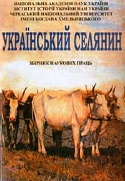Боротьба кримських татар із радгоспами на південному березі Криму у 1923 році (за матеріаліами літерної справи «Міллі-фірка» iз ГДА СБУ)
##plugins.themes.bootstrap3.article.main##
Анотація
Метою дослідження є вивчення боротьби кримськотатарського селянства Південного
берега Криму з радянськими господарствами (радгоспами) на завершальному етапі масового штучного
голоду 1921–1923 рр. на підставі аналізу матеріалів справи «контрреволюційної організації «Міллі-Фірка»,
яка зберігається у Галузевому державному архіві Служби Безпеки України. Висновки. Дослідження
здійснено із застосуванням загальнонаукових і спеціально-історичних методів. Комуністичний режим
наприкінці 1920 – на початку 1921 рр. активно насаджував радгоспи на націоналізованих землях
Криму, втім через їхню неефективність та спротив селянства кількість таких господарств вже
за рік скоротилася майже у 10 разів. Винятком став Південний берег Криму, де більшість радгоспів
продовжували функціонувати на колишніх землях царської фамілії, аристократії та царських сановників.
Це призвело до поглиблення катастрофи в роки голоду серед селян південнобережжя, більшість із
яких була малоземельними і безземельними кримськими татарами та страждала від неможливості
орендувати землю. Аналіз матеріалів «справи «Міллі-Фірка», яку у 1928 –1930-х рр. вели каральнорепресивні органи СРСР проти кримськотатарської інтелігенції та активістів, свідчать про активні
дії кримськотатарських інтелігенції та селян із захоплення земель та розподілу майна радгоспів в районі
Ялти. Аналіз інформації із справи «Міллі-Фірка» дозволяє уточнити уявлення, які присутні в історіографії
про «пасивність» кримських татар під час масового штучного голоду в Криму 1921–1923 рр., від якого
кримськотатарський народ постраждав найбільше серед всіх кримських етноспільнот. Матеріали,
що містяться у справах карально-репресивних органів СРСР, свідчать про активні спроби у 1923 р.
кримськотатарських селян та інтелігенції вирішити на Південному березі Криму питання безземелля і
малоземелля шляхом захоплення земель радгоспів.
##plugins.themes.bootstrap3.article.details##

Ця робота ліцензується відповідно до Creative Commons Attribution-NonCommercial 4.0 International License.
Посилання
Bekirova, H. (2015). Asan Sabri Aivazov. Proekt Krym.Realii. Retrieved from https://ru.krymr.com/a/27389551.html [in
Russian].
Bykova, O. S. (2012). Holod 1921–1923 rr. u Krymu [The famine of 1921–1923 in the Crimea]. Extended abstract of
candidate`s thesis. Zaporizhzhia [in Ukrainian].
Bykova, O. S. (2012). Prychyny holodu 1921–1923 rokiv v Krymu [The causes of the famine of 1921–1923 in the Crimea].
Naukovi pratsi istorychnoho fakultetu Zaporizkoho natsionalnoho universytetu – Scientifi c edits of the historical faculty of
Zaporizhia National University, 32, 216–223 [in Ukrainian].
Bykova, O. S. (2011). Rehionalni osoblyvosti holodu 1921–1923 rr.: Povolzhia, Krym, pivden Ukrainy [Regional features
of the famine of 1921–1923: Volga region, Crimea, southern Ukraine]. Naukovi pratsi istorychnoho fakultetu Zaporizkoho
natsionalnoho universytetu – Scientifi c edits of the historical faculty of Zaporizhia National University, 31, 134–135 [in
Ukrainian].
Bykova, T. B. (2020). Istorychni peredumovy y perebih leninsko-stalinskoi kampanii tataryzatsii v Krymskii ASRR
(1921–1928 rr.) [Historical preconditions and the course of the Leninist-Stalinist campaign of Tatarization in the Crimean
Autonomous Soviet Socialist Republic (1921–1928)]. Kyiv: Instytut istorii Ukrainy NAN Ukrainy [in Ukrainian].
Bykova, T. B. (2011). Stvorennia Krymskoi ASRR (1917–1921 rr.) [Creation of the Crimean ASSR (1917–1921)]. Kyiv:
Instytut istorii Ukrainy [in Ukrainian].
Broshevan, V. M., Formanchuk, A. A. (1992). Krymskaia respublika: god 1921-y: (Kratkii istorycheskii ocherk) [Crimean
Republic: year 1921: (Brief historical sketch)]. Symferopol: Tavriia [in Russian].
Vozghryn, V.E. (2013). Istoryia krymskykh tatar: ocherky etnycheskoi istoryii korennoho naroda Kryma v chetyrekh
tomakh [History of the Crimean Tatars: essays on the ethnic history of the indigenous people of Crimea in four volumes]. (Vol.
III). Simferopol: KRP «Izdatelstvo «Krymuchpedhyz». [in Russian].
HDA SBU. F. 13. Spr. 1121.
HDA SBU. F. 13. Spr. 1125.
Zarubin, A. H. & Zarubin, V. H. (2008). Bez pobedytelei. Iz istorii grazhdanskoi voiny v Krymu [No winners. From the
history of the civil war in the Crimea]. Simferopol: AntykvA [in Russian].
Zarubin, V. H. (2003). Holod 1921–1923 gg.. v Krymu (po svodkam ChK/HPU) [Famine 1921–1923 in the Crimea
(according to the reports of the Cheka / GPU)]. Istorycheskoe nasledie Kryma – Historical heritage of Crimea, 2, 68–74. [in
Russian].
Yshyn, A. V. (2004). K voprosu ob osobennostiakh polytycheskogo razvityia Kryma v pervoi polovine 1920-kh godov
[К вопросу об особенностях политического развития Крыма в первой половине 1920-х годов]. Istorycheskoe nasledie
Kryma – Historical heritage of Crimea, 5, 48–50 [in Russian].
Kondratiuk, H.M. (2013). Krymski tatary v umovakh holodu 1921–1923 rokiv [Crimean Tatars during the famine of
–1923]. Holod v Ukraini u pershii polovyni XX stolittia: prychyny i naslidky (1921–1923, 1932–1933, 1946–1947) –
Famine in Ukraine in the fi rst half of the twentieth century: causes and consequences (1921–1923, 1932–1933, 1946–1947):
Proceedings of the International Scientifi c Conference. Kyiv, November 20–21, 2013 (pp. 75-81). Kyiv [in Ukrainian].
Kondratiuk, H. (2012). Natsionalna polityka RKP(b) i holod v Krymu u 1921–1922 rokakh [National policy of the RCP
(b) and the famine in the Crimea in 1921–1922]. Visnyk Prykarpatskoho universytetu. Istoriia – Bulletin of the Precarpathian
University, 21, 46–51 [in Ukrainian].
Ivanets, A., Kohut, A. (Ed.) (2019). Krymskotatarskyi natsionalnyi rukh u 1917–1920 rr. za arkhivamy komunistychnykh
spetssluzhb [Crimean Tatar national movement in 1917–1920 according to the archives of communist special services] Kyiv:
K.I.S. [in Ukrainian].
Bahrov, N.V. (predsedatel), M. R. Akulov, V. D. Arbuzov and other (Ed.) (1981). Ocherky istorii Krуmskoi oblastnoi
partiynoi orhanyzatsii [Essays on the history of the Crimean regional party organization]. Simferopol: Tavriia. [in Russian].
Valiakyn, A. V., Khaialy, R. Y. (Ed.) (2009). Posledniaia rukopys Sabry Aivazova. Delo partii «Milli Firka». Dokumenty
svidetelstvuiut. Iz serii «Rassekrechennaia pamiat». Krymskii vypusk. Vol. 1. Simferopol: Dolia [in Russian].
RDASPI. F. 19. Op. 3. Spr. 231.
Usov, S. A. (1925). Istoriko-ekonomicheskie ocherki Kryma. Proshloe i nastoiashchee krymskogo selskogo
khoziaistva [Historical and economic essays of Crimea. Past and present of Crimean agriculture]. Simferopol: 1 Hospolyt.
«Krympolygraftresta», 320 [in Russian].
Khaiali, R. I. (2010) Etnosotsiokulturna evoliutsiia krymskotatarskoho narodu v XX st. [Ethnosociocultural evolution of
the Crimean Tatar people in the twentieth century]. Extended abstract of candidate`s thesis. Lviv [in Ukrainian].

